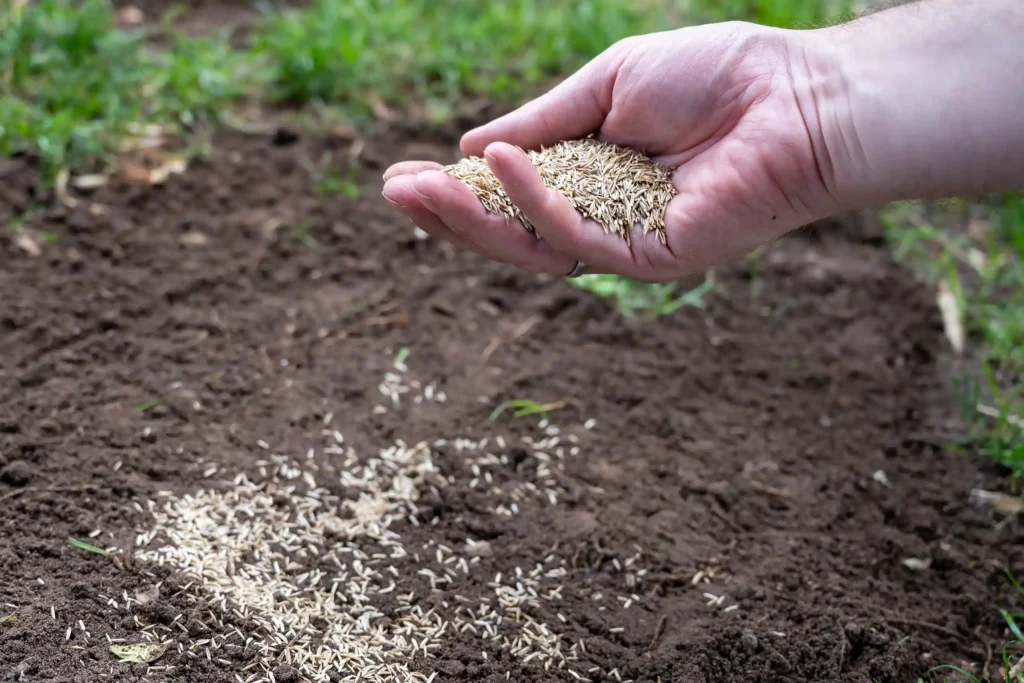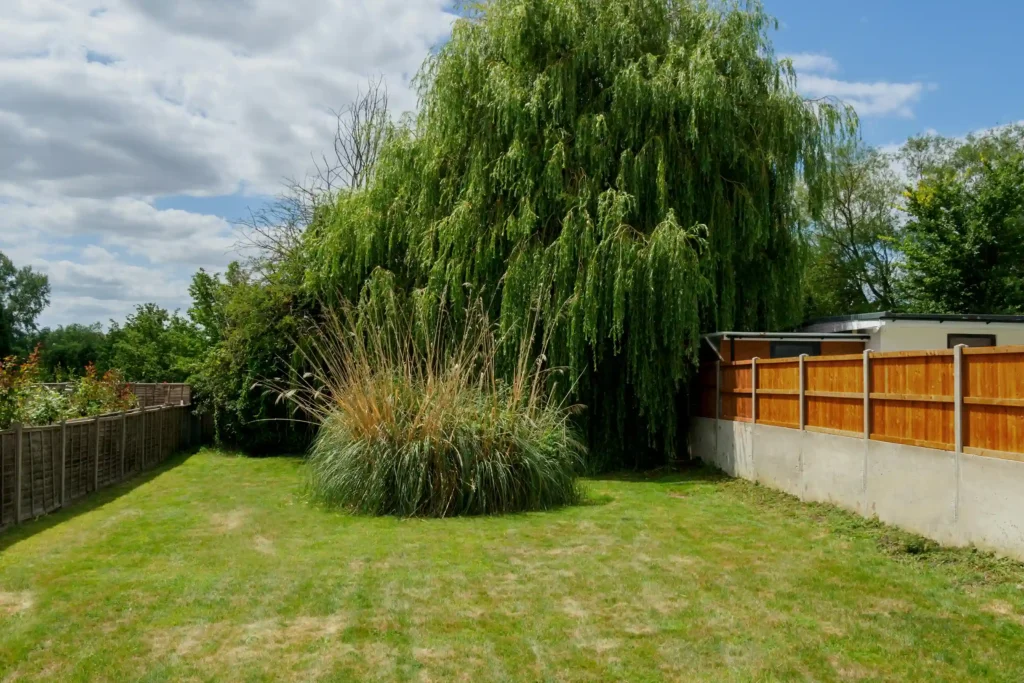Planting grass seeds may sound simple, but creating your dream lawn does require some careful planning and precision.
Lawns come in all shapes and sizes, so knowing the precise amount of grass seed you will need is essential to achieving a lush and healthy lawn.
Moreover, knowing how to accurately measure your lawn can save you time and money, as you will not be sowing or buying any grass seed you do not need.
In this guide, we will help you navigate the complexities of measuring your lawn, calculating grass seed quantities, and how to avoid common mistakes.
Whether you are overseeding your lawn or starting from scratch, these tips will help you create the ideal foundation for your grass seeds to flourish.
How big is the yard?
The first and most important step to determining how much grass seed you need is knowing the exact size of your yard.
To do this, you should measure your lawn in terms of square footage, as different types of grass and applications require different amounts.

If you work off estimates, you may find that you are left with wasted seeds, or worse, a sparse and patchy lawn.
Accurately measuring your lawn ensures full coverage and promotes strong and even growth.
Why is yard measuring important?
It is important to remember that the amount of grass seed you use is not only important for appearance but also for your lawn’s strength and health.
If you use too little seed, you will effectively be underseeding your turf, which can result in bare patches or thin grass.
On the other hand, if you use too much seed, you will be overseeding, which leads to waste and overcrowding.
Measuring your lawn precisely allows for even distribution, which helps create a thicker lawn that is more resilient against foot traffic and requires less maintenance over time.
What influences the quantity of grass seed?
Achieving a thick and healthy lawn is not just about scattering grass seed and hoping for the best but about understanding how much you actually need.
Here are the factors you should consider when determining the amount of grass seed you need:
- Lawn size and shape. Larger gardens may require more seed, while lawn shape also matters, as irregular shapes may require additional seeds to ensure even coverage.
- Type of grass. Different types of grass have unique needs and seeding requirements. Your grass choice will directly influence how much seed you need.
- New lawn or overseeding. Planting a new lawn requires more seed to establish a thick initial layer, while overseeding requires a lower seed rate to fill in any bare or thin areas.
- Lawn usage. If your lawn is heavily used, you may want to consider a higher seed rate to increase your grass’ density and durability.
How do I measure my lawn size?

Now that you are aware of the importance of measuring your yard and the factors you need to consider, it is time to delve into how you can accurately measure your lawn.
Before you start, you will need to ensure that you have the following tools to carry out your measurements:
- Tape measure. A 100-foot tape is suited and recommended for most residential lawns.
- Pen and paper. Useful for recording measurements and sketching out your lawn.
- String or gardening stakes. Can be helpful for irregular-shaped lawns and for making specific points on your lawn, such as corners.
If you have a larger lawn, you may want to consider using these additional tools:
- Measuring wheel. Ideal for speeding up the process of measuring larger areas.
- Laser distance measurer. Delivers high-precision measurements and is useful for more challenging areas.
- Smartphone apps or GPS. These tools can create a digital outline of your lawn and measure distances.
How to measure different lawn shapes
Measuring a lawn does not have a one size fits all approach, as gardens come in a variety of shapes and sizes, with each requiring its own method to produce accurate measurements.
Here is a list of the most common lawn shapes and how you can measure them easily and effectively.
Circular lawns
Measuring your circular-shaped lawn might seem daunting at first, but it could not be simpler.
To get the exact measurements, you will need to use the Pi formula (Π) to find out the radius and diameter of your lawn.
For the radius (half the width of the circle):
The formula is: radius x radius x Pi
If your lawn is 7m by 7m, you would use this formula: 7m x 7m x 3.14 (Pi) = 154m2
For the diameter (the width of the circle):
The formula is diameter ÷ two, squared x Pi
So, if our diameter is 12m, this would be: 12 ÷ 2 = 6. 6m2 is 36 x Pi = 113m2
Rectangular or square lawns
This lawn shape is the most common and the easiest to measure accurately.
All you need to do is measure the length and width of your lawn, then simply multiply these measurements to get the total area of your lawn.
For example, if your lawn is 9m in width and 7m in height, you would use this formula:
9m x 7m = 63m2
Triangular lawns
Triangular lawns may seem like they could be tricky, but it is just a case of using another basic formula to get an accurate measurement.
You will need to measure the base (one side of the triangle) and the height, then multiply these figures and divide them by two.
For example, if your lawn had a base of 14m and a height of 10m, the formula would be: 14m x 10m = 140 ÷ 2 = 70m2
Irregular-shaped lawns
It is not uncommon to have an irregularly shaped lawn; however, this can make it trickier when you need to find the exact area to measure.
A simple solution is to divide your lawn into shapes, such as a circle, square, and triangle.
Separating your irregularly shaped lawn into manageable shapes can make the process much simpler.
You can then measure each section using the previous formulas recommended for each shape.
Using a grass seed calculator
Whether you are new to lawncare or a seasoned expert, one tool that can be greatly useful for simplifying this process is a grass seed calculator.
Using this tool is a great way of ensuring that you are not overestimating or underestimating the amount of seeds you need.
A grass seed calculator is simple to use and can assist you with a variety of lawn shapes, whether that’s triangular or irregular shapes.
When using a calculator, start by inputting the measurements of your lawn, which you calculated earlier using the above methods.
Once you have done this, you can then select your desired sowing rate; however, it is important to remember that different types of grass have different sowing rates, so make sure you are choosing the best fit for your lawn.
After adding all of this information, the calculator will work out the exact amount of seed you need to sow to achieve a thick and luscious lawn.
We recommend planning for all eventualities and ordering approximately 30% more grass seed than you think you will need.
Ordering extra grass seed allows you to account for factors like seed loss due to birds.
Common mistakes to avoid when measuring your lawn
Measuring your lawn is key to calculating the correct amount of grass seed needed.
However, mistakes can happen, so we wanted to highlight the most common ones so you can plan effectively and avoid them:
- Estimating measurements. This is going to lead to you buying too much or too little grass seed, resulting in uneven application and waste. Always use proper measuring tools when measuring your lawn.
- Ignoring irregular shapes. Not breaking your lawn into more manageable shapes can lead to inaccurate measurements and grass seed quantities.
- Not accounting for obstacles. Another regular error is not including permanent obstacles, such as trees, pathways, and flower beds within measurements. If you will not be covering these areas, then you can simply subtract them from your total.
- Miscalculating areas. Before you start measuring, ensure you are following the correct formula for your lawn type.
- Using incorrect units. If you are using inconsistent units to measure your yard, it can easily get confusing. Try to measure using the same unit, or if this is not feasible, ensure that all units are accurately converted before you start calculating.
- Leaving out slopes and uneven areas. Although these can be trickier to measure, they must be considered when measuring your lawn.
Ready to create your dream lawn?
Achieving a lush and resilient turf starts with precise planning and taking accurate measurements.
Taking the time to measure your lawn properly ensures that you are applying the right amount of grass seed, even application, and avoiding waste.
Start your journey to a thicker and more vibrant lawn today and take our quiz to find the perfect bundle for your lawn’s needs.
